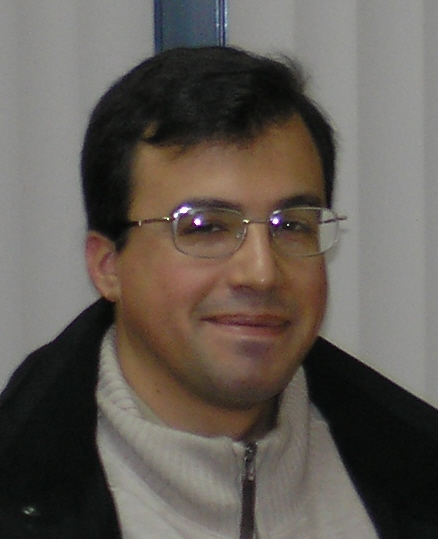Education: PhD in Physics, University
of Seville.
Doctoral thesis: Mechanics of cohesive
granular media and their relation to the forces between
particles.
Supervisor: Antonio
Castellanos Mata.
Main scientific results:
In this work we measured
the self-diffusion coefficient of a bed particles with the
size of the order of 10 micrometers which presented an
apparently homogeneous fluidization. Fluidization is a
type of multiphase flow in which particles are suspended
in a flowing fluid, in our case a gas. The most common
description of a multiphase flow uses a equation similar
to the Navier-Stokes equation for every single phase
(fluid and particles) with a coupling term between the two
phases. When particles and fluid are perfectly mixed (on a
larger scale than the particle size) fluctuation is said
to be homogeneous. Nevertheless, the analysis of the
stability of the solutions of the coupled Navier-Stokes
equations that describe the multiphase flows predicts that
the solution in which the particles and the flow are
perfectly mixed is unstable, in other words, that
homogeneous fluidization is not possible. Since
homogeneous fluidization is apparently observed in some
beds of particles, some previous works supported the view
that a homogeneously fluidized bed consisted in a network
of particles at fixed positions forming a weak porous
solid. We disproved this model demonstrating
experimentally that in an apparently fluidized bed
particles have a non-zero self-diffusion coefficiente. The
existence of a self-diffusion coefficient implies that
each particle moves with a velocity different than that of
its neoghbours, that is, that particles do not form a
solid. Moreover, we were able to measure the dependence of
the self-diffusion coefficiente with the superficial fluid
velocity.
In colloid science the
term jamming transition refers to the cessation of the
movement of the particles in the colloid when the solid
fraction reaches a certain value. At the transition the
particles form a permanent network of contacts capable of
supporting stresses (in theory, just at the transition,
these stresses have to be infinitesimally small). The
solid fraction at the jamming transition, depends on the
intensity of interparticle attractive forces. Usually
these attractive forces are short ranged and therefore
they only act at particle contacts. In this work we
demonstrated experimentally that a fluidized bed of
particles also experiments a jamming transition (for a
description of what is a fluidized bed go here. The
difference with the case of a colloidal suspension is that
in a colloidal suspension the solid fraction increases due
to particle settling while in fluidized bed the solid
fraction can be controlled by changing the superficial
fluid velocity. For fluidized particles, the stregngth of
attractive forces depends on their superficial properties.
Using particles with the same superficial properties (that
is, having attractive forces of the same intensity) we
found that the solid fraction at the jamming transition
depended on the particle size. However, when it is
considered that the particles in the fluidized bed forms
aggregates, and these aggregates are taken as effective
particles the effective volume fraction of aggregates at
the jamming transition is independent of particle size..
It has been proposed
that some dynamic system display a behaviour termed
self-organized criticality, in which the system remains in
a steady state even though there is an external forcing,
through events that lack a typical size and whose
temporary intervals also lack a typical time. In these
events the energy that the external forcing has stored in
the system is dissipated. Earthquakes and avalanches in
granular materials appear in the literature as typical
examples of self-organized criticality. In fact, some
authors have presented experimental works in which they
recorded the statistics of the avalaches of a granular
media in a rotating drum and concluded that their
experimental results were consistent with the existence of
self-organized criticality. We did not agree with that
point of view, at least for granular materials with
particle sizes on the order of ten microns or less. In
these materials the attractive strenghts between particles
are important for the behavior of the material. This fact
made us think that in these materials there is a
characteristic length given by the distance in which
changes in the components of the stress tensor are
comparable to the cohesion of the material resulting from
the attractive forces between particles. So we set our own
experiment in which we recorded the statistics of
avalanches of micrometer-sized materials in a rotating
drum. We used different materials with different cohesion.
As expected, the avalanchas had a typical size which
depended on the cohesion of the material.
In this article we
presented a semi-analytical model for the adhesive
elasto-plastic contact between a deformable sphere and a
rigid semi-space. An elastic-plastic contact is one where
a region within the deformable body/s in which deformation
is irreversible (plastic deformation) surrounded by
another region where the deformation is reversible
(elastic deformation). Only the elastic deformation is
recovered when the load force on the bodies in contact is
removed. As a result, the bodies in contact are distorted
and the curve of load force against deformation during
unloading differs from that obtained during the contact
loading. Although there are analytical models for the
elastic contact (only reversible deformation) and the
loading of a plastic contact (irreversible deformation
only), the existing models describing the full cycle of
loading and unloading of an elastoplastic contact were too
simplified. The reason is that to locate the boundary of
the region of plastic deformation within the bodies in
contact the stresses inside them must be solved
self-consistently. This is not easy without drastic
simplifications. Our model is an improvement over existing
ones that, in our opinion, makes more reasonable
simplifications, although at the expense of a somewhat
higher mathematical complexity. The model assumes that the
load force applied on the sphere is normal to the contact
surface and there is no friction in the contact area. In
the limit in which the region of plastic deformation
occupies the entire contact area, this model tends to the
model developed by S. Mesarovic and Johnson Dj. Mesarovic
and K. L. Johnson, Adhesive contact of elastic-plastic
spheres, J. Mech. Phys Solids 48, 2009-2033 (2000). The
model was compared with molecular dynamics simulations of
the contact between a deformable sphere and a rigid half
space. The degree of similarity between the results of the
numerical model and the semi-analytic was remarkable.
In a atomic force
microscope (AFM) the image of a substrate is constructed
from the deflection and / or the torsion that a cantilever
experiments when scanning the substrate. Specifically, in
the mode of operatior termed Lateral Force Microscopy
(LFM), the cantilever is rastered on the substrate
perpendicularly to its long axis, causing a torsion of the
cantilever. The torsion is measured by a laser beam that
reaches a multiple phpotodioed after being reflected on
the cantilever. In this paper we presented a method to
calibrate the sensitivity of an AFM to lateral forces
exerted on the cantilever when used in this way. The
sensitivity is the constant that relates the output signal
from the photodiode (in volts) with the cantilever torsion
(in radians). The method is applicable to cantilevers that
have a particle attached in a position displaced with
respect to the long cantilever axis and it is an
adaptation of the method described in A. Feiler, P.
Attard, and I. Larson, Rev. Sci Instum. 71, 2746 (2000).
The advantage over the method of Feiler is that the
sensitivity calibration is done simultaneously with the
acquisition of data, which, in addition to save of time,
avoids errors due to changes in sensitivity caused by
having to assemble and disassemble the cantilever between
the calibration and the measurements. Our method can also
be used to measure the torsional spring constant of the
cantilever. The torsional spring constant relates the
angle of torsion of the cantilever with the torque acting
on it. However, for this type of measurement it is
necessary to ensure that the cantilever is perfectly
aligned perpendicularly to the plane of the photodiode..
Main scientific publications:
Authors: Miguel Ángel Sánchez
Quintanilla, Dave Goddard .
Authors: Francisco Antonio
Gilabert Villegas, Jose Manuel Valverde, Miguel Ángel
Sánchez Quintanilla, and Antonio Castellanos Mata.
Authors: Miguel Ángel Sánchez Quintanilla, Jose Manuel
Valverde, Antonio Castellanos.
Authors:Antonio Castellanos Mata, Jose Manuel Valverde
Millán, Miguel Ángel Sánchez Quintanilla.
Authors: Jose Manuel Valverde Millán, Antonio
Castellanos Mata, Miguel Ángel Sánchez Quintanilla.
Patents:
Popularization books:
Granular Media Technology. Santander (SPAIN).
Secretariat of Publications of the University of Seville.
2008.
Authors: Valverde Millán, Jose Manuel, Castellanos
Mata, Antonio, Sánchez Quintanilla, Miguel Ángel.
Surface analysis using the AFM contact mode. In:
Encyclopedia of Tribology. Springer-Verlag Berlin
Heidelberg. 2013.
Authors: Sánchez Quintanilla, Miguel Ángel.
Structuring of particles and production stress in
magnetofluidized beds. Vol. 1254. Pag. 33-38. In: Porous
Media and Its Applications in Science, Engineering, and
Industry: 3rd International. The American Institute of
Physics. 2010.
Authors: Valverde Millán, Jose Manuel, Espín Milla,
Manuel Jesús, Sánchez Quintanilla, Miguel Ángel, Castellanos
Mata, Antonio.
Magnetofluidization of fine magnetite particles.
Vol. 1145. Pag. 119-122. In: Powders and Grains 2009:
Proceedings of the 6th International Conference on
Micromechanics. The American Institute of Physics. 2009.
Authors: Sánchez Quintanilla, Miguel Ängel, Espín
Milla, Manuel Jesús, Valverde Millán, Jose Manuel,
Castellanos Mata, Antonio.
Alternating field electrofluidization. Vol. 1145.
Pag. 97-100. In: Powders and Grains 2009: Proceedings of
the 6th International Conference on Micromechanics. The
American Institute of Physics. 2009.
Authors: Espín Milla, Manuel Jesús, Valverde Millán,
Jose Manuel, Sánchez Quintanilla, Miguel Ángel, Castellanos
Mata, Antonio.
PhD supervisor:
Optimization of CO2 capture through fixed and
fluidized beds of calcium-based adsorbents at laboratory
scale. Doctoral Thesis. 2016.
Author: Ebri Pérez, Jose Manuel
Propagation of sound in cohesive granular media.
Doctoral Thesis. 2017.
Author: Ruiz Botello, Francisco.
For any questions or suggestions contact me through my
email.

